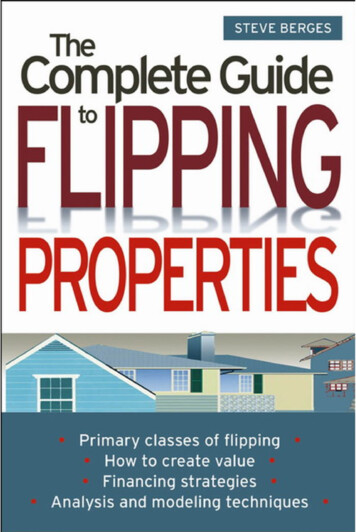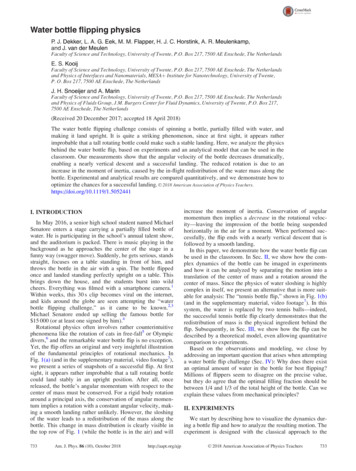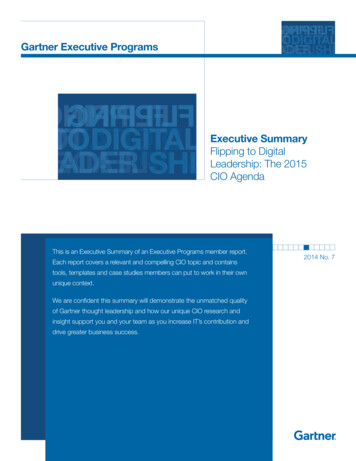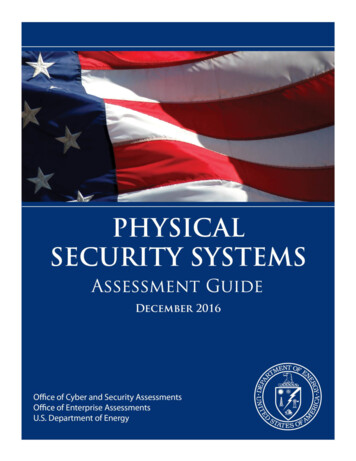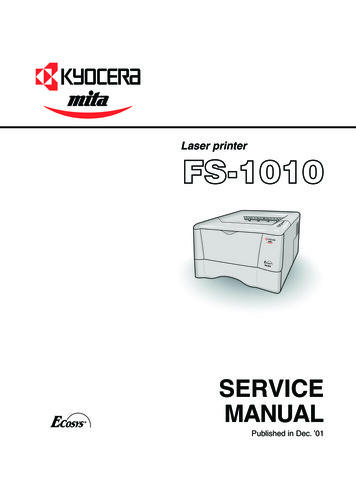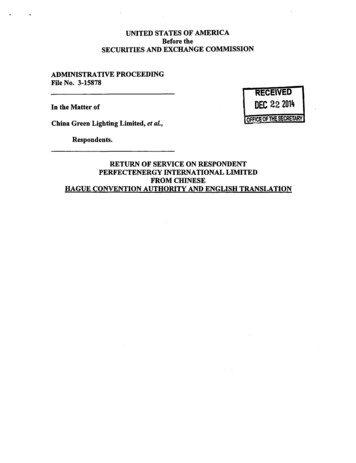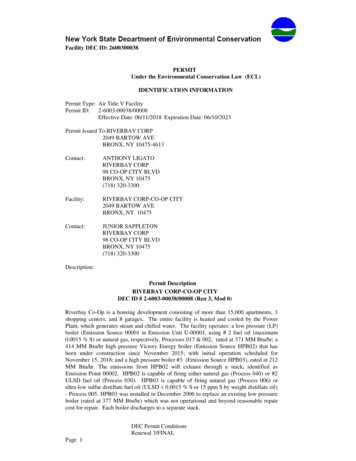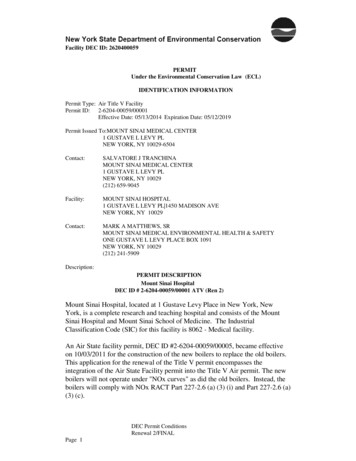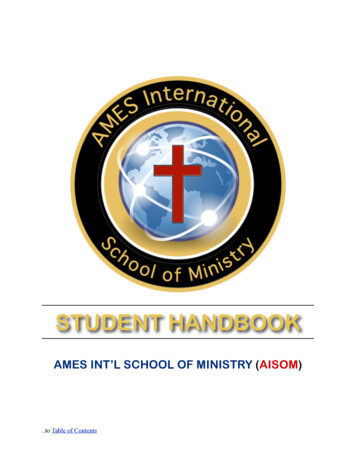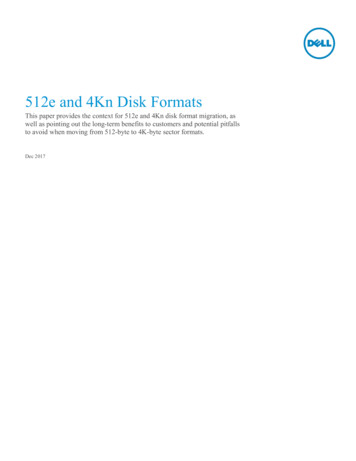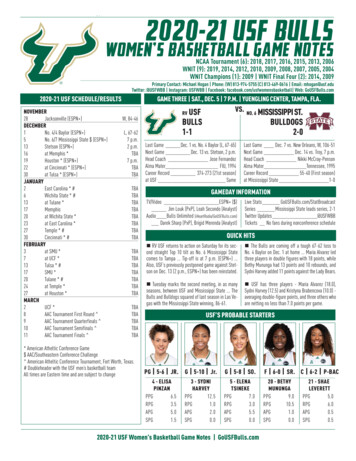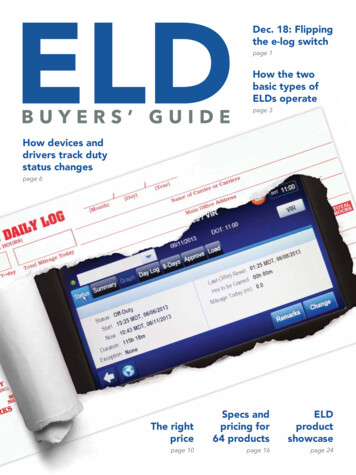
Transcription
Dec. 18: Flippingthe e-log switchpage 1How the twobasic types ofELDs operatepage 3How devices anddrivers track dutystatus changespage 6The rightpricepage 10Specs andpricing for64 productspage 16ELDproductshowcasepage 24
TOPPICK!Transflo TelematicsCompliance at your fingertipsTelematics PortalElectronic LogsTransflo T7 ELDDuty StatusSpecial ELD Promo! Purchase an ELD today and receive a free monthlysubscription until March 2018.*We know the ELD mandate is a change for truckers, and we’re tryingto make it easy. The Transflo ELD T7 is priced at less than 99 andinstalls in minutes; no mechanic, no special tools. Simply manage logs,duty status, and inspection reports from a mobile app. You can evenmanage documents, loads, dispatch chat, and settlement statementsas part of the Transflo mobile suite. Manage your whole workday fromone app. It’s as easy as it gets.813.386.6000 sales@transflo.com www.transflo.com/*Offer valid October 1, 2017–December 31, 2017. Standard ELD monthly service plan applies. One month up-front payment of 25required; no further payments until March 2018; 25 per month thereafter. Must purchase and activate by December 31, 2017. 2017Pegasus TransTech, LLC. All rights reserved. Transflo and the Transflo logo are trademarks of Pegasus TransTech, LLC. PegasusTransTech is an Authorized Geotab Reseller. TF10162017You can now purchasethe Transflo ELD T7 atparticipating truck stops.
Since the Federal Motor Carrier Safety Administration’slate 2015 release of its finalrule for using electroniclogging devices, there’s been a risingswell of ELD development. Customers can choose from hardware andsoftware options offered by dozensof vendors, many of them new to thetrucking industry.This also means serious preparationon the enforcement side. FMCSA hashad reported delays implementingits roadside data-transfer system bywhich officers will interface electronically with any of these systems.Nevertheless, the agency expects tohave it in place prior to Dec. 18, thescheduled enforcement date for usingelectronic logs.Fleet-focused onboard devices offera lot of bells and whistles, but independent owner-operators are likely togravitate to a baseline-compliance device. They can benefit from additionalDO YOU USE ANY FORM OFAN ELECTRONIC LOGBOOKIN YOUR OPERATION?Yes, a smartphoneapp untethered tothe engine 7%Yes, an engineconnected e-logplatform 11%No82%An Overdrive survey from a year agoshowed minimal e-logging by owner-operators. Since then, many largerfleets have added ELD systems to geta jump on compliance before Dec. 18,but some independent owner-operators have yet to install an ELD.functions such as IFTA data collection,making mileage tracking automaticand easily reportable.As you’re making your decision,consider these issues:Support. The final rule specifiesan eight-day timeframe for repairing/replacing a malfunctioning ELD. Doesthe provider stock the kind of hardware inventory to meet such a quickturnaround? How are replacements/repairs handled?For carriers needing more than eightdays to replace any ELD, the rule alsospelled out a process for requestingmore time. It involves contacting yourstate’s FMCSA division office and making your case.FMCSA registry and compliance.Technically, compliant ELDs must beon FMCSA’s registry of devices. Theagency’s vetting process does not entailtesting for compliance, relying largelyon manufacturers to self-certify thatthey meet the rule specs.That’s prompted worry among motorcarriers about what happens if theirdevice is later found to be noncompliant. FMCSA’s website addresses thatscenario: “FMCSA will work withaffected motor carriers to establish areasonable timeframe for replacingnoncompliant devices.”At this stage, part of the complexityinvolving the registry is that automaticonboard recording devices meetingfairly minimal requirements comparedto ELD specs are essentially grandfathered through Dec. 16, 2019. Therule notes that any carrier installingan AOBRD prior to this year’s ELDenforcement date can use that deviceuntil the 2019 date.EXEMPTIONS: FEWBEYOND OLDER ENGINESPerhaps the biggest exemption toFMCSA’s ELD requirement is the exclusion of trucks with 1999 and oldermodel-year engines from complying.Narrower exemptions exist for thefollowing applications: Drivers in drive-away/tow-away operations, where the vehicle being drivenis the commodity being delivered. Drivers operating under the timecard exception to the hours-recordingrules – the 100- and 150-air-mile radius short-haul exceptions – exclusively. Drivers who occasionally keep alogbook but do not do so for morethan eight days in any 30-day period.Practically, what that means is thatenforcing the requirement to use aregistry-listed device is unlikely beforethat time, particularly for carriers whocomply with the ELD rule and installan engine-connected e-log prior toDec. 18. So the registry’s importancefor carriers choosing ELDs at this stageis minimal.As the comparison chart of devicesbeginning on p. 16 of the ELD Buyers’Guide shows, some established ELDvendors remain off the registry. Thoseproviders consulted for stories in thisbuyer’s guide, if not already on theregistry, expressed plans for eventualELD compliance for their productsthrough firmware/software updates asthe enforcement rollout progresses.Nonetheless, for any product notlisted on the registry, ask the vendor about its plans for registering itsdevice and whether it has a plan forsuccess and support for its productbeyond 2019.november 2017 eld buyers’ guide1
It’s our mandate to help you.)Electronic Logs)DVIR)Navigation)Messaging)GPS TrackingHands-on Training No Cost Consulting Dedicated ELD TeamTailored GPS Tracking & E-Log Solutionsa 877-477-2690 l GPSINSIGHT.COM
How the two basictypes of ELDs operateABY TODD DILLSll compliant electronic logging devices will sharea common bond: They can record data coming infrom the system that controls the truck’s engineand component parts. The final rule from theFederal Motor Carrier Safety Administration was specific inrequiring synchronization with the electronic control module. That’s one of the reasons the agency didn’t require ELDsin trucks with model-year 1999 or older engines.The rule requires ELDs to automatically record date,time, location information, engine hours, vehicle miles andidentification information for the driver, carrier and vehicleitself. Unless the driver is enabled for use of the vehicle in a“personal conveyance” mode outside of work hours, ELDsare required to record all of those elements “when the driverindicates a change of duty status or a change to a specialdriving category” such as a yard move, the rule states.When in motion, ELDs are required to record all of theinformation on an hourly basis at a minimum. Many ELDsare offered as part of systems built for detailed tracking purposes, useful to fleets and owner-operators for purposes suchas automatic notification of arrival times.Those systems are capable of recording in a much morerefined manner, and some may default to that. Providers mayor may not have the ability to adjust the refinement.Though there are plenty of variations, two types of ELDshave emerged, as labeled on the chart that begins on page 16:In dedicated unit configurations, the device is suppliedby the provider and is likely to remain in the truck.BYOD (“bring your own device”) systems allow buyers topurchase their own hardware for the driver interface, such asan owner-operator using an app on a personal Android- oriOS-powered smartphone. A carrier may seek out a deal ontablets to dedicate to its power units and drivers.Dedicated unitsMost older forms of electronic logging devices, known as electronic onboard recorders (EOBRs) or automatic onboard recording devices (AOBRDs), have been the dedicated-unit type. Twoexamples that have been available for years are Omnitracs’ MCPseries and PeopleNet’s current products used by many driversemployed by or leased to larger carriers.Many of these units provide ELD functionality in a singledevice package tied directly to the ECM by a cable and plug.Like mobile phones, such units use connections to thecellular network and GPS functionality to deliver on theELD rule’s requirements for recording location, mileage andengine hours. Data storage occurs using a combination of theinternet cloud, back-office servers and the device itself.A notable exception among devices available for years nowexists in the base model of the Continental VDO RoadLog,which is limited to hours of service recording and inspection-report functionality.With no connection to the cellular network with thedevice, fleets and owner-operators manage data storage viaa USB-connected drive to transfer records to a laptop orother computer.Other dedicated devices may pair two pieces of hardware,bridging the gap between the traditional single-unit EOBRand the two-piece BYOD systems readily available today.In most cases, those devices are in evidence on the chartwhen a BYOD and a dedicated version exist from onemanufacturer. While the J.J. Keller Encompass and RandISE Fleet Services’ eFleetSuite baseline compliance device is adedicated unit with its own cellular data connection but withouta lot of extra functionality beyond logs.november 2017 eld buyers’ guide3
PA R T N ER S O LU T I O N S / C O R E T E XWhy putting all youreggs in one basketmakes perfect sense.ELD is here, it’s realand it’s now.But not all ELD solutions arecreated equal, so what are theright questions to ask beforedeciding on an ELD provider?The first question is usually a financial one. Do you wantto comply for the least possible cost, or do you see ELDas an opportunity to solve a series of other complianceissues at the same time?If you run a mixed fleet of trucks, trailers, reefersand straight trucks then ELD is arguably the perfectopportunity to make your operation a whole lot smarterand more efficient.By looking at ELD as a feature within a suite, rather thana standalone system, operators can use the compulsoryinvestment in ELD to address other compliancechallenges, such as FMSA, DVIR and IFTA. This savesmoney because it displaces the technical solutionordinarily required for each mandate and also allowsoperators to introduce efficiency and safety features, thatwill more than offset any additional cost.The usual argument is that features included as part of asuite, are never as good as a dedicated system. If you’rebuying a stereo that’s probably right, but if you’re buyingan ELD solution then it’s wrong. ELDs that are integratedinto a suite are better, because they can drive other tasksand business processes, like DVIR and job dispatch.
Powered byBeyond FSMA, ELD, DVIR and IFTA, the right fleetmanagement system should incorporate a host ofother features that help operators run safer andmore efficient operations.Integrated features include: High Definition vehicle tracking ABS / Remote tire inflation monitoring Driver behavior monitoring with camera monitoringas an option Trip replay and black box reporting Engine management data reportingThe best ELDs are: Service manager Easy for drivers and back office staff to learn and useIn the same way that not all ELDs are equal, notall fleet management solutions are equal. Thebest systems: Able to support a range of different rule sets anddriver types Easily portable between vehicles Integrated into a broader system Rock solid and reliableFor operators that haul reefers, FSMA is about tobecome a big deal, with some serious consequencesfor operators caught asleep at the wheel. The right fleetmanagement solution, will give operators all the twoway remote control tools necessary, to meet their FSMAobligations and become a preferred carrier. And, in thecase of straight trucks, it should achieve this using asingle piece of in-vehicle hardware. Allow operators to see their fleets in High Definitionfrom the same platform Are active, rather than passive, allowing operatorsto manage by exception Are tightly integrated into all of the majorTransportation Management Systems (TMS)So, if you’re a fleet operator and you see ELD as anopportunity to change your business, then you shouldlook for an integrated fleet management solution, likeCoretex 360, that offers ELD as part of a powerful suiteof fleet management features.Don’t just loghours. Get moreout of them.Turn compliance into acompetitive advantage with afully integrated ELD solution.coretex.com/eld
ELD BUYERS’ GUIDEMcNally HD100 systems both are BYOD-capable, they alsoare offered with company-branded Android tablets thatcome preloaded with software: the Compliance Tablet fromJ.J. Keller and the TND from Rand McNally.Any fleet or owner-operator willing to make the investment in dedicated tablets can turn a BYOD system into adedicated one.Jack Schwalbach, who manages the private fleet ofReinders, a Wisconsin-based turf and irrigation productscompany, moved all of his trucks’ tablets to ELD functionality by signing on with Geotab’s program for leasing engineconnection hardware to pair to tablets.“We have dedicated tablets,” Schwalbach says. “The tabletsare used just for logging – the data plan, we have lockeddown. Everybody’s got their smartphone on their own, sothey use that” for anything else.Bring your own deviceThe “bring your own device” phrase and its BYOD acronymcame into use with the profusion of smartphones over thepast decade. In trucking, it’s a common term to describe amajor part of today’s ELD market.Dozens of providers are offering their own versions ofBYOD systems. A BYOD-configured ELD consists of a“dongle” that connects to the ECM via the cab’s onboarddiagnostics port. The dongle typically pairs via a Bluetoothconnection with a smartphone or tablet to transmit data.Software from the ELD vendor on your smartphone ortablet enables you to change duty status manually when youstop. When your vehicle goes into motion, the ELD automatically will shift to the drive line in the logbook.Variations exist. The engine-connection dongle may ormay not have a cellular connection. In the case of the KeepTruckin ELD, the ECM-connected device maintains a GPSconnection but no cellular connectivity itself. For that, thesystem relies on the connected smartphone or tablet and itsdata plan.Meanwhile, Geotab’s Go — also a BYOD solution (andmarketed as the Transflo ELD T7 by Pegasus TransTech) —maintains its own cellular connection and is capable of beingupdated and troubleshot over the air if software/firmwareupdates are needed.How devices and driverstrack duty status changesWPrevious versions of rules that would have mandated electronic logsfor some carriers would have required the devices to notify driversregarding their hours status when they were approaching a limit. Thatfeature is not a part of the device specs for the new rule, but manye-log providers offer quick-glance views, such as the one shown fromERoad, that amount to quick-compliance dashboards, showing timeremaining in the daily and cumulative hours limits.6eld buyers’ guide november 2017BY TODD DILLShile electronic logs generally automate partsof logkeeping and in some ways simplify therest, they still require direct driver involvement in most duty status changes. As anydriver will know, too, turning the entire process over to adevice and its interaction with the truck just isn’t possible.As with paper logs, drivers using electronic logs are in controlof all duty status inputs. The exception is the drive line, whichfunctions automatically as specified by the Federal Motor Carrier Safety Administration’s final rule. It’s also the only status thedriver will be unable to edit directly through his driver login.To minimize the need for annotations required with anyedit, the long-in-practice habit of “catching up the logbook”by drivers will mostly fall by the wayside. With no pencil tobe pushed across paper, as long as the device is operationaland open, duty-status changes happen with the simple pushof a button in real time.
AT&T Fleet CompleteReliable ELD compliancethe easy wayAT&T Fleet Complete’s ELD solution is an easy-to-use integratedsolution that covers your fleet’s ELD compliance from start to finish.It operates under 11 interstate and cross-border ELD rules in both,the U.S. and Canada, and provides automated DVIR reporting forquick and easy vehicle inspections. With this solution, all data issecure and easily accessible in the AT&T Fleet Complete portal.Get ahead of the curve and get yourbusiness ELD ready today! Learn more atatt.fleetcomplete.com/eld or call us at1-844-944-0870.Leading ELD appThis app is your driver’ssafety and compliancemanager that accuratelyrecords daily logbooks.Fast roadsideinspectionsAll critical information isaccessible at a touch of ascreen, making roadsideinspections quicker withminimal paperwork.FlexibilityEasy reportingBetter load planningDrivers are always incontrol of the ELD deviceand can edit logs with areason code.Get a grid view of driverlogs and summary reportson drive time, events, andmileage.Having near real-timevisibility on driver’s dutystatus allows for optimalload planning while stayingELD compliant.Proud Winner of Frost & Sullivan Awardfor Customer Value Leadership in ELDSolutions IndustryELD SOLUTIONS INDUSTRY 2017 AT&T Intellectual Property. All rights reserved. AT&T and the AT&T logo are trademarks of AT&T Intellectual Property.
ELD BUYERS’ GUIDECourtesy of Mobile Warriorto 0 miles per hour and stays at 0 milesEdits made by the driver are possibleper hour for 3 consecutive seconds,”for every line but the drive line, whichafter which manual duty status changesis locked down since drive time isare possible.based on vehicle movement. The driveFMCSA noted it would expect thatline can be edited from the administrainmost cases drivers would make ator’s account to classify an unassignedduty status change in such an eventdriving event or drive time as personalbefore shutting the vehicle down.conveyance or a yard move.The ELD will record all engine on/Any edits made from the adminisoff activity.trator account in the back-office login3) The default duty status for anymust be certified as accurate by theELD is on-duty not-driving. Absent adriver. This occurs through the driver’sdriver’s direct change, after the vehicleuser interface of the ELD when the edithas been in motion, the ELD automatiis made.cally should transfer the driver to LineAn independent owner-operator4 after the vehicle has been stationarymay have two separate logins for thefor five minutes.system: one as a driver, the other as the4) Yard moves functionality wasadministrator. An independent lackingspecified in the ELD final rule astwo email addresses may need to geta way for carriers to move vehiclesa second one. Some systems requirearound company terminals withoutunique addresses to associate with theautomatically triggering an on-dutylogins as administrator and driver-user.driving status.When it comes to the look and feelYard-moves mode for particularof the user interface that e-log providerdrivers will be enabled from the admincompanies are required to produce, theistrator account and then selected byELD final rule leaves plenty of room forRay Cox, Mobile Warrior sales director, sayshiscompany’siDDLdevicehasa“touchthe driver when making a yard move.variation. It did, however, make thesefree ELD gauge.” The screen, locked whileThe default status for a yard move isrequirements of all ELDs:the truck is in motion, “shows the driverLine 4, on-duty not-driving.1) A graph grid of any driver user’severything going on from a complianceperspective. Our gauge will show how many5) Personal conveyance uses of thehours analogous to that used in paperhoursandminutesareleftbeforethedrivertruck while off-duty also are enabledlogs, showing the various off-duty,must take a 30-minute break or how longfrom the administrator account forsleeper berth, driving and on-dutythey have left for driving, and if they havedrivers. The personal con
Electronic Logs Duty Status Telematics Portal Transflo Telematics Compliance at your fingertips TOP PICK! Special ELD Promo! Purchase an ELD today and receive a free monthly subscription until March 2018. We know the ELD mandate is a change for truckers, and we’re trying to make it
